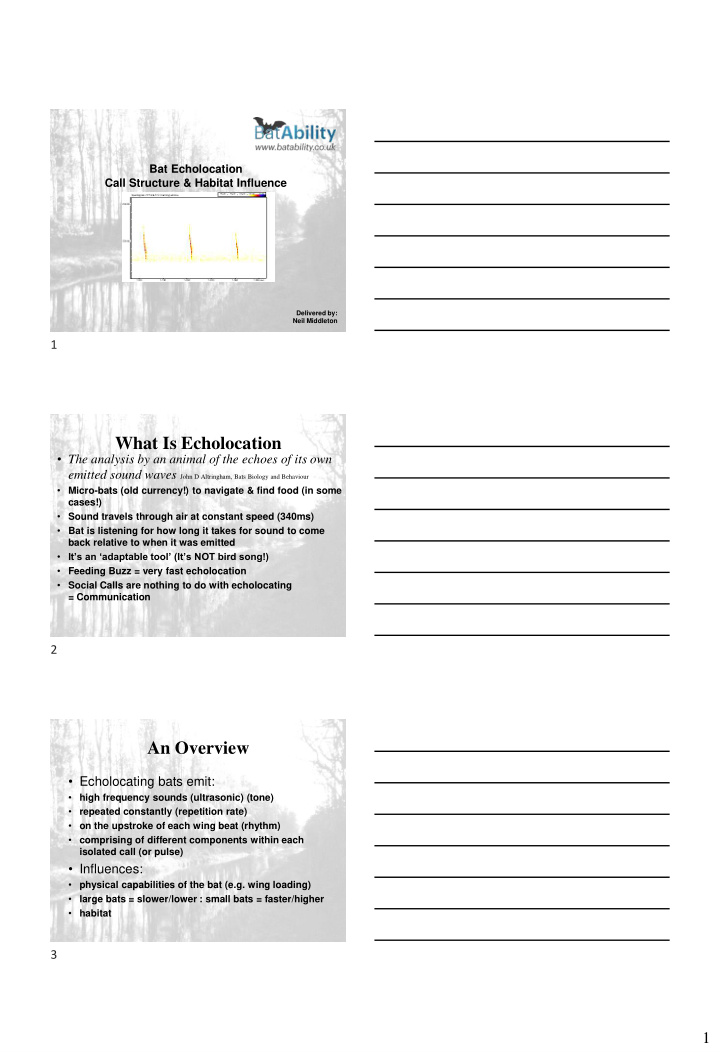



Bat Echolocation Call Structure & Habitat Influence Delivered by: Neil Middleton 1 What Is Echolocation • The analysis by an animal of the echoes of its own emitted sound waves John D Altringham, Bats Biology and Behaviour • Micro-bats (old currency!) to navigate & find food (in some cases!) • Sound travels through air at constant speed (340ms) • Bat is listening for how long it takes for sound to come back relative to when it was emitted • It’s an ‘adaptable tool’ (It’s NOT bird song!) • Feeding Buzz = very fast echolocation • Social Calls are nothing to do with echolocating = Communication 2 An Overview • Echolocating bats emit: • high frequency sounds (ultrasonic) (tone) • repeated constantly (repetition rate) • on the upstroke of each wing beat (rhythm) • comprising of different components within each isolated call (or pulse) • Influences: • physical capabilities of the bat (e.g. wing loading) • large bats = slower/lower : small bats = faster/higher • habitat 3 1
4 Pipistrellus spp. Freq (kHz) detail 55kHz Spip 45kHz Cpip distance 40kHz Npip Closed Edge Open Faster Reps Slower Reps Higher Freq Lower Freq More FM Less FM Time (ms) 5 Habitat Influences • Open Space • Use lower rep rates • Use long range echo’, loud, lower frequency & regular • Have a longer CF component • Change direction less often • Flies faster = less wing beats (e.g. Nyctalus ) • Clutter • Use faster rep rate • Shorter & quieter calls • Use FM • Flies slower = more wing beats (e.g. Natterer’s) • Edge Habitat? 6 2
Fast Wingbeat Slow Slow Flight Speed Fast Detail Information Distance Myotis spp. Pipistrellus spp. Nyctalus spp. Plecotus spp. Serotine Freq Closed Edge Open Time 7 Others • Horseshoe spp • Barbastelle 8 Call Structure • Can comprise of a FM component and a CF component • Broadband = FM bats/components • Short sweep down through frequencies (iow the frequency alters during the call) • Good for detail at close range & accuracy • Narrowband = CF bats (almost!)/components • Longer call covering narrower frequency range (iow the frequency remains constant and the pulse lasts longer) • More effort concentrated in one area over longer time • Good for distance • Horseshoe bats & Doppler shift (i.e. the pitch of a sound rises or drops as a sound source moves) 9 3
Call Structure Frequency/Amplitude Higher Frequencies Pick Out Detail & Lower Frequencies Don’t attenuate as Smallest Objects (e.g. insects) quickly over distance & better for relatively larger stuff & giving echoes back from more distant objects As Distance From Bat Increases Overall Effectiveness of Echolocation Reduces 10 Attenuation 11 No Ways It’s A Giveaway 12 4
Measuring Call Parameters 13 Harmonics 14 Search Phase Calls Better for ID 15 5
Habitat Influence on Bat Call ID Leisler’s As the bat moves to an Open setting the Nyctalus call structure becomes more distinguishable Noctule Closed Edge Open 16 Bat Echolocation – Species ID 17 Pipistrellus spp. 18 6
Nyctalus spp. 19 Myotis spp. • All fast rep rates • All FM bats (no CF tail) = dry clicks • Very difficult to ID to species level, however… • Sometimes you can get there - almost! 20 Q&A 21 7
Thanks For Attending Today ^ ☺ ^ Contact Info: Neil Middleton BatAbility Courses & Tuition Email: neil.middleton@batability.co.uk R Mobile: 07877 570590 22 8
Recommend
More recommend